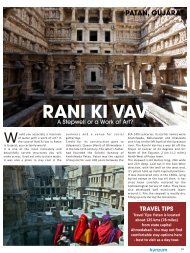DELHI
Download - Kunzum
Download - Kunzum
- No tags were found...
Create successful ePaper yourself
Turn your PDF publications into a flip-book with our unique Google optimized e-Paper software.
Jahaz Mahal<br />
Jahaz Mahal<br />
This pavilion is built on the banks of the Hauz-i-Shamsi,<br />
or water reservoir. One is not sure of the origins, but it<br />
may have been built around the 15th century in the Lodi<br />
period. It could have served as a serai or a rest house for<br />
travellers, or as a retreat for the later Mughal emperors.<br />
It is also the venue of the annual Phoolwalon ki Sair, the<br />
procession of florists held around October. The reservoir<br />
itself may have been built around 1230 A.D. by Iltutmish.<br />
Unfortunately, it requires cleaning up and a conservation<br />
effort to restore it to its original pristine state. And a<br />
commitment by residents not to throw garbage or wash<br />
clothes in it. Across the road, through some slums is<br />
another place called the Jharna meaning waterfall. It was<br />
built within some Mughal Gardens around 1700, and water<br />
from the reservoir would flow into it. This water would be<br />
used to run fountains, and to further channelize it for use<br />
of residents.<br />
Mehrauli village is clearly a case of being a rich place going<br />
to seed – but it is still worth the obstacle course created by<br />
high density living and poor maintenance.<br />
Shrine of Khwaja Qutubuddin Bakhtiyar Kaki<br />
Many an emperor and other nobles preferred to be buried in the area as it was the khanqah or blessed area of the Sufi<br />
saint and mystic, Qutubuddin Bakhtiyar Kaki, who came from Iran and died in 1235 A.D. His shrine adjoins the Zafar<br />
Mahal, and is one of the more revered destinations for the devout.<br />
21








